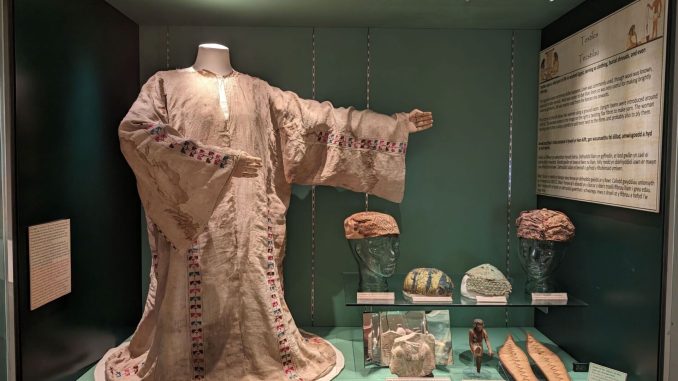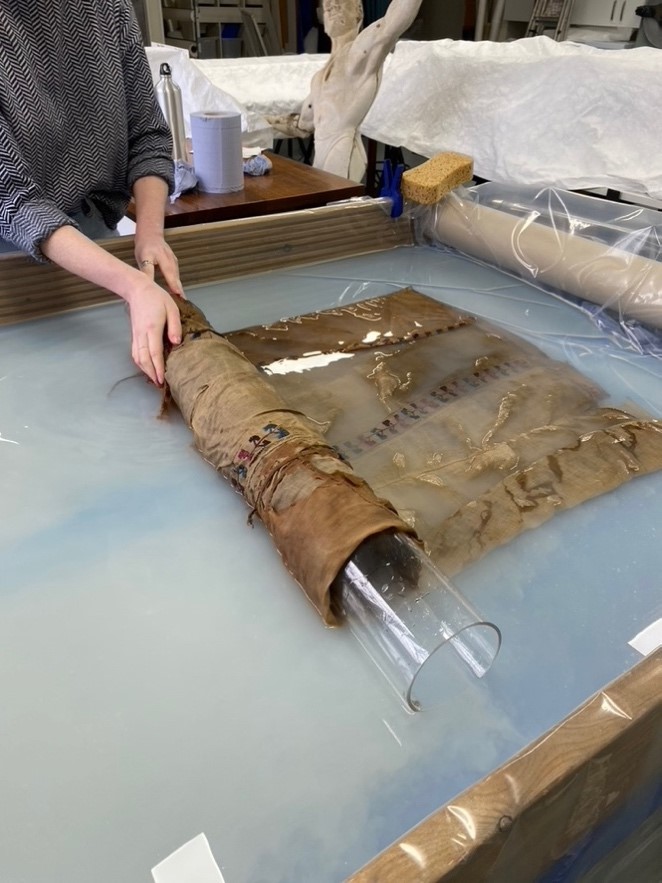
A rare tunic is now back on display at Swansea University’s Egypt Centre after two years of extensive restoration work.
Part of the Wellcome Collection housed at the Egypt Centre, the tunic was bought at auction by Sir Henry Wellcome in 1906 when it was described as being made of embroidered Coptic linen. But experts now say its panelled construction does not match any Coptic-labelled garments in other major museum collections. In fact, there are more similarities in construction with Mamluk period tunics which date from between 1250 and 1517 CE.
The garment is made up of 13 linen panels decorated with blue, pink, burgundy, and yellow silk designs. Colourful patterns are woven between the individual fibres of the linen cloth, creating identical patterns on both the outside and inside of the tunic.
Before treatment, there were large areas of loss across the back of the shoulders and neckline, vertical tears on the front and back of the garment, large stains, and dark, brittle tidelines. The tunic was heavily creased, after being stored flat for many years, and it even showed signs of possible previous machine washing.
The Egypt Centre wanted the tunic to be stabilized and mounted onto a mannequin to better display it to the public.
The painstaking work was carried out at Cardiff University’s conservation lab by Deirdre Ellis and Jessica Morgan. Using their expertise, they decided wet cleaning would be the most effective way to lessen the creasing and realign the weave of the linen. It was essential that the creasing was minimised as much as possible before attaching the stabilizing fabric, otherwise the folds would become more brittle, and breakable, over time.

Before cleaning began, fragments of the tunic that had already become detached were tested with Fourier Transform Infrared spectroscopy to determine the source of the staining. There was very little surface dirt which suggested it had most likely been cleaned since its excavation.
After cleaning a panel of silk, crepeline fabric was used to stablise the garment. This was stitched in place using conservation grade thread – the superfine thread size allowed stitches to pass through the weave of the linen without splitting the linen fibres.
The pair used very fine entomological pins and beading needles during the process to minimise the size of stitching and pinning holes.
To mount the tunic, a shop mannequin was padded out to give the illusion of a body under the garment. A custom-made calico lining was also created to add volume to the tunic and to protect the hem from the base of the display case.
Now, the result of their hard work is being enjoyed by visitors to the museum on the University’s Singleton campus.
Egypt Centre curator Dr Ken Griffin said: “We are absolutely delighted to have the tunic back on display. The amazing work by the conservation students has really transformed our textile exhibition, with visitors to the museum in recent weeks amazed by the quality of preservation.
“This project really demonstrates the excellent partnership between the Egypt Centre and Cardiff University conservation department.”
The tunic is now on permanent display in the Egypt Centre’s House of Life gallery, exhibited alongside other textiles from Egyptian history.
Find out more the Egypt Centre’s online catalogue
